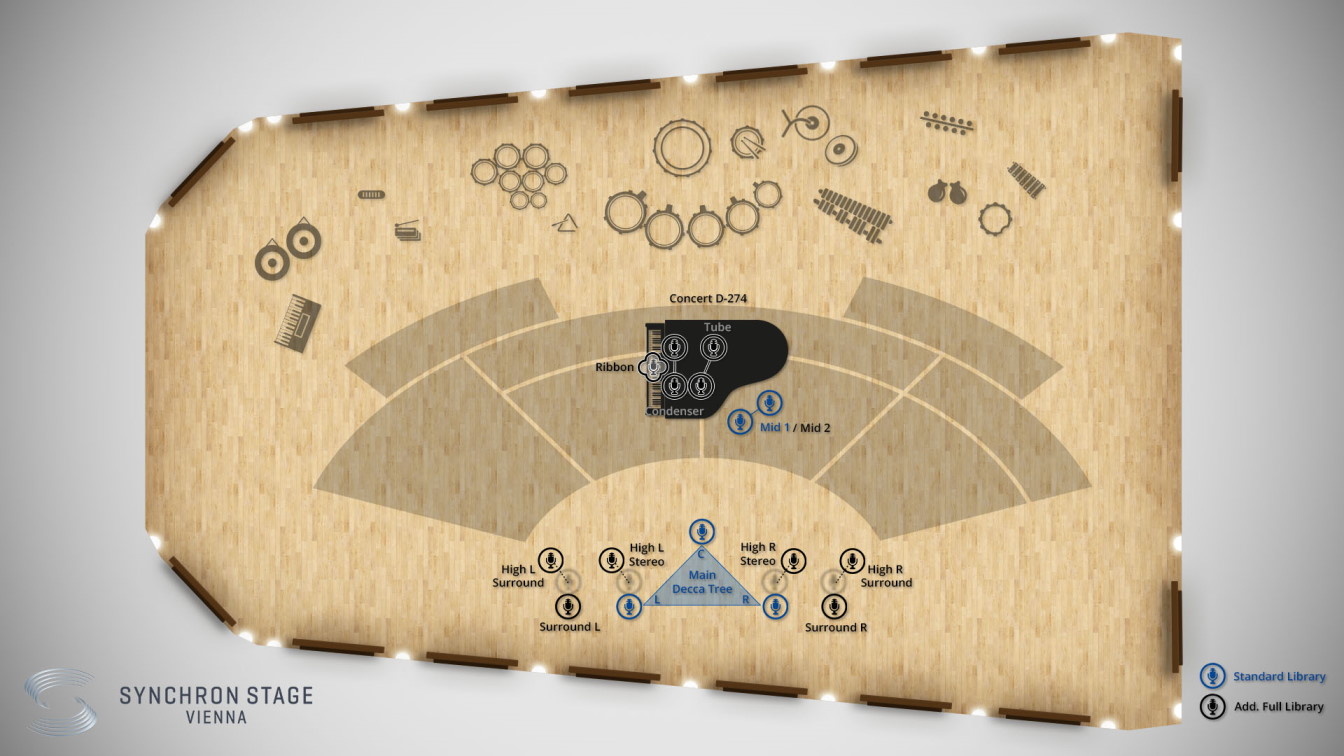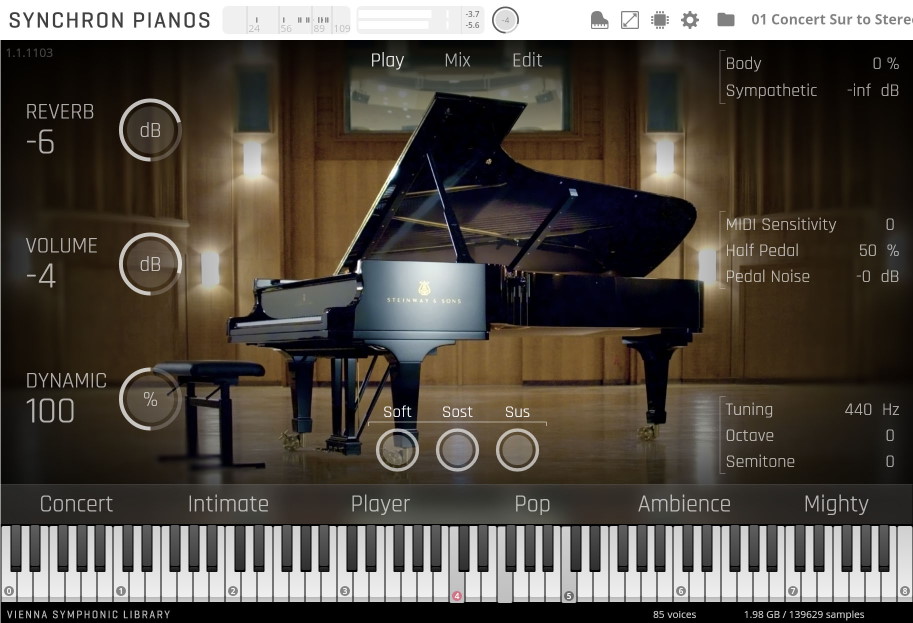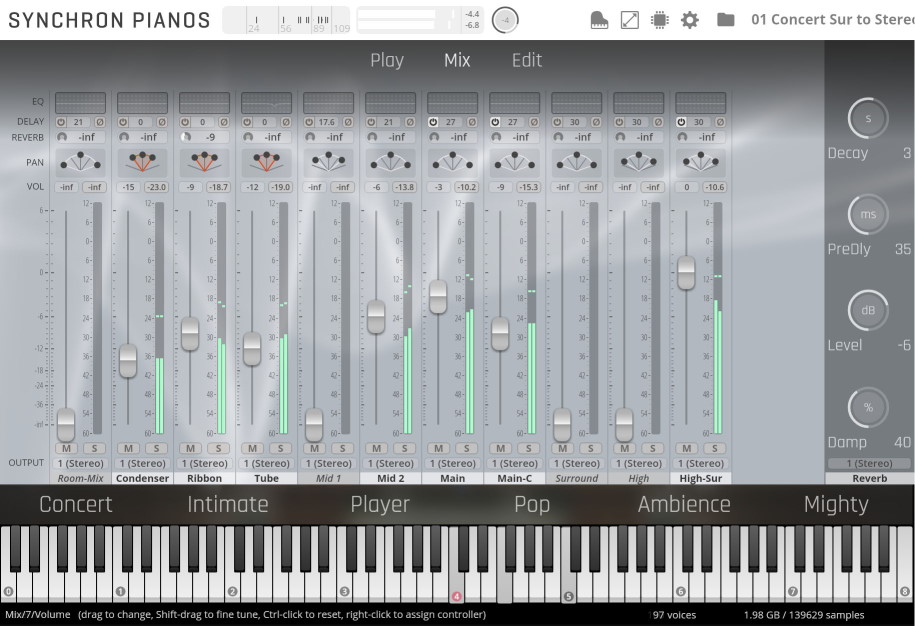Concert D-274
Introduction
The Steinway & Sons D-274 is the flagship model of world-renowned piano manufacturer Steinway & Sons. This beautifully hand-crafted instrument with its laminated wooden housing and its poured iron frame has not changed much since it was first developed at the end of the 19th century. With a length of 274 cm (almost 9 ft.) and a weight of almost 500 kg (1,100 lb.), the Steinway D-274 continues to play a significant role in the global music industry. An estimated 90% of all concert grands on the world's stages are Steinway D-274 models, delighting its players and audiences alike.
The reasons are obvious: Especially when competing with orchestras, the D-274 impresses with its tremendous assertive sonic volume and power – which is not surprising considering its soundboard of almost two square meters (21.5 sq.ft.)!
Leading artists of all eras have appreciated playing a Steinway D, from Sergei Rachmaninoff, Vladimir Horowitz, Arthur Rubinstein, and Glenn Gould, to today's top-notch pianists, such as Pierre-Laurent Aimard, Emanuel Ax, Hélène Grimaud, and Lang Lang, just to name a few.
Standard and Extended Library
The instrument was recorded using 10 microphone positions. The Standard Library includes 4 of these sections, allowing you to integrate instruments recorded with a stereo Decca tree into your projects using our new Synchron Player software. Adding the Extended Library and thus getting the Full Library expands your possibilities to 5.1 surround and Auro 3D 9.1.
Microphone positions
With over 4,000 samples per key and almost 20,000 samples per microphone position, the Synchron Concert D boasts breathtaking authenticity. In order to capture this marvelous instrument in one of the best acoustic environments on the planet, our recording engineers used multiple high-end microphone arrays, affording an abundance of options for creating your individual sound.

Standard Library
- Room Mic (Mix)
- The Room Mix channel contains a stereo mix of all available room microphones from the Full Library
- Condenser - Close 1 (Sennheiser MKH 8040)
- "ORTF" setup with a pair of Schoeps MK 4, positioned as closely as possible over the hammer area. Ideal for producing the typical "pop piano" sound.
- Mid 1 (Sennheiser MKH 800)
- "ORTF" setup with a pair of Sennheiser MKH 800 mics for a wide, warm yet bright and centered sound.
- Main/Room Mic – Decca Tree Stereo (L/R)
- Decca Tree array (L-C-R) with three DPA 4006 mics. These very neutral microphones captured even the smallest detail of Synchron Stage Vienna. Used in a stereo mix, you can easily hear where the piano is placed. In a surround setup, the Decca tree microphones will be the feed for your front L-R speakers.
- Main/Room Mic – Decca Tree Mono (Center)
Extended Library
Even if you're not using a surround setup, you get more ambience variation and spatial depth out of the Full Library by adding the room microphones' signals to your stereo mix.
- Ribbon - Close 2 (Royer SF-24)
- "Blumlein" setup with two ribbon figure-eight capsules of a Royer SF-24 mic, for a fast, direct, and natural sound.
- Tube - Close 3 (Neumann M149)
- "ORTF" setup of a Neumann M-149 stereo pair, capturing the beauty of the Steinway D with the analog warmth and richness only a legendary tube microphone can provide.
- Mid 2 (Sennheiser MKH 8040)
- "ORTF" setup with a pair of Sennheiser MKH 8040 mics for a centered, but harder and more focused sound than the MID 1 Position.
- Main Surround – Stereo (L/R)
- Wide A-B stereo setup with two DPA4011 cardioid microphones. You may use them as so-called "Wides" or "Outriggers" in a stereo mix in order to create an even more spacious impression. In a surround setup, these microphones would be used for your rear speakers.
- High Stereo (3D) – Stereo (L/R)
- Stereo A-B-setup with two AKG C-414 condenser microphones, spotting the very nice reflections of Synchron Stage Vienna's ceiling. In stereo mixes, you can use them as an alternative to your main mics, or you may down-mix these much more diffused signals. The sound is more "sparkling" and reverberant compared to the main mics. Used in an Auro 3D or Dolby Atmos mix, these microphones should feed your top or ceiling speakers.
- High Surround (3D) – Stereo (L/R)
- Like the High Stereo (3D) setup, this A-B array features two AKG C-414 microphones.
The instrument Presets also include different mixer presets. By default the classic room mixes are loaded which include the Standard Library microphone positions. These are balanced in the stereo field to represent the respective instrument's position in the Synchron Stage set-up.
Immersive Sound and Auro 3D
Auro 3D is an immersive audio technology that allows for three-dimensional sound perception. The Belgian company Auro Technologies developed this technology based on a special speaker configuration, adding four additional speakers to a 5.1 surround configuration. These speakers (so-called "Heights'') are situated above the front and surround speakers and generate acoustic reflections that are perceived naturally due to the fact that sounds originate from around as well as from above the listener. Thanks to the comprehensive selection of discrete audio channels with the Full Library of Synchron Percussion I you may mix your instruments in Auro 3D as well as in Dolby Atmos.
About Pitch
For designating pitch, the Vienna Symphonic Library uses International Pitch Notation (IPN), which was agreed upon internationally under the auspices of the Acoustical Society of America. In this system the international standard of A=440 Hz is called A4 and middle C is C4. All pitches are written as capital letters, their respective octave being indicated by a number next to it. The lowest C on the piano is C1 (the A below that is A0), etc.
Walkthrough Videos
About this piano
Our very own Steinway & Sons D-274 is a "Hamburg Model" and was hand picked from eight Steinway D models by Stefan Mendl, founding member and pianist of the Vienna Piano Trio. In a city rich with glorious instruments, it is ranked among the best sounding grand pianos in Vienna, and has been endorsed by all artists who have had the opportunity to play it. The instrument enjoys permanent, climate-controlled residency at Synchron Stage Vienna, which is characterized by its particularly warm, intense, and natural ambience. The hall has lent its acoustic signature to numerous international productions, from classical chamber music to international, large-scale orchestral film scores.
Key Features
- Steinway & Sons D-274, Hamburg Model
- Over 4,000 samples per key for maximum authenticity, liveliness, and feel.
- Recorded in the natural ambience of one of the best recording halls in the world, Synchron Stage Vienna
- Utmost realism, capturing all of the instrument's nuances with our proprietary precision sampling technology
- Hyper-realistic playing feel
- Multiple microphone positions – for a multitude of timbral variations
- Intuitive, customized Synchron Pianos software with high-performance playback engine
- Six pre-configured presets: "Concert", "Intimate", "Player", "Pop", "Ambience", "Mighty"
- Soft (una corda), sostenuto, sustain pedals
- Half-pedalling and re-pedalling
- Sympathetic resonance
- Body resonance
- Dedicated release samples, depending on played release velocity
- Detailed pedal sounds for soft and sustain pedals, depending on pedal speed

Advanced Release Sample Technology
To capture the Steinway D with all its subtleties, our engineers developed a highly precise motion-control system based on a solenoid that controls a noise-free "robot finger". The micro-controller moves the finger with super-human precision, providing flexible curvatures for down-strokes and release movements. The MIDI controlled system delivers more than 100 velocities and various release samples, depending on the preceding note length and various release speeds.
This innovation represents the pinnacle of our long-term sampling robotics development. An earlier version of the robot finger was used for sampling the Celeste found in our Synchron Percussion I Collection.
Customize Your Personal Sound
In addition to the multitude of options from mixing various microphone signals, the Synchron Concert D comes with our free Vienna Synchron Pianos Software that offers multiple options for shaping your sound and the playing experience. Hosting a high-performance playback engine, the software provides a musician-friendly user interface that allows for quick and easy timbral control. Create your sound intuitively by filtering particular key ranges or even single keys, adjust the body resonance of the instrument or add just a pinch of algorithmic reverb to refine the overall sound.

Included Presets
In the browser window of the Synchron Pianos player you may select from four general preset categories
Room Mix (Standard Library)
Ready-made, resource saving presets with as few microphones as possible. The "Room Mix" Channel contains a mix of all available microphones from the Full Library.
Decca Tree Multi Mic (Standard Library)
The classic sound of a Decca tree stereo recording features a more slender sound with less diffusion compared to the "Room Mix" Presets.
Surround to Stereo Downmix (Full Library)
These presets include all available room microphones with various runtime delays, creating more diversity in the perception of room depth.
Surround (Full Library)
Designed to send the microphone signals to your available surround channels.
Character Presets
The Synchron Pianos player interface offers instant and direct access to seven pre-configured character presets.
1. Concert
- Character: A grand spatial representation of the Steinway & Sons D-274 at Synchron Stage Vienna.
- Perspective: Conductor, with the instrument at its original recording position in the center.
- Mix: Additional Reverb on the Close and MID microphones, with a 35 ms runtime delay on the Room Mix channel.
- Recommendation: Piano concerts
2. Intimate
- Character: Close, charming sound with attenuated treble register and added Body Resonances.
- Perspective: Player, centered
- Mix: Little reverb on the Close microphone, with a 33 ms runtime delay on the narrowed Room Mix channel.
- Recommendation: For intimate ballads and low, mighty chords.
3. Player
- Character: Natural, close sound without any additional EQing and a soft touch of the room. Immediate response with the full stereo width of the keyboard. The real Steinway & Sons playing feel.
- Perspective: Player, centered
- Mix: Very little additional reverb on the Close microphones, with dampened high frequencies and a 21 ms runtime delay on the narrowed Room Mix channel.
- Recommendation: Ideal recording preset
4. Pop
- Character: Powerful and assertive, with reduced MIDI sensitivity, accentuated low and high frequencies and a short reverb.
- Perspective: Player, centered
- Mix: Little additional reverb on the MID microphones, with bolstered deep and high frequencies and a 21 ms runtime delay on the narrowed Room Mix channel.
- Recommendation: For the modern songwriter, for live solo peformances and within a band context.
5. Ambience
- Character: Spacious, roomy, washy, with soft attacks. Assertive sound even in the background of a mix.
- Perspective: Conductor, with the instrument at its original recording position on the right.
- Mix: Much reverb on all microphones and a 27 ms runtime delay on the Room Mix channel.
- Recommendation: Soaring melodies, lush arrangements, film scores.
6. Mighty
- Character: Bouncing, echoing sound with a distinctive slapback.
- Perspective: Conductor, with the instrument at its original recording position in the center.
- Mix: Much reverb on all microphones, with EQ adjustments. The slapback is created with the runtime delays for the Mid microphone and Room Mix channel. You may adjust it to fit the tempo of your music.
- Recommendation: Scenes with cinematic landscapes, wide fields, industry halls or concrete walls.